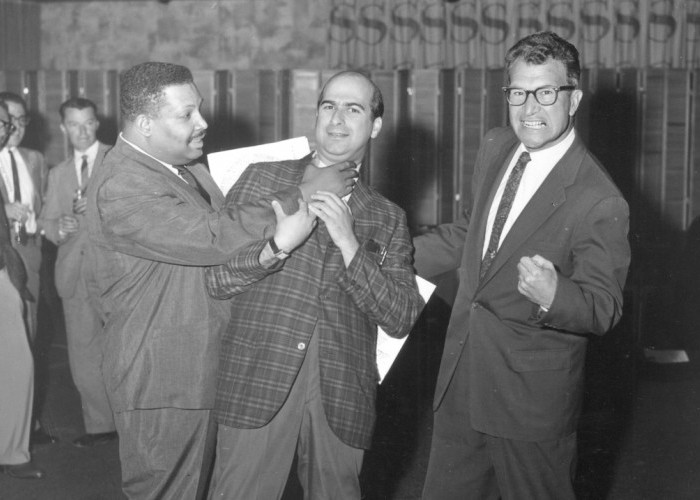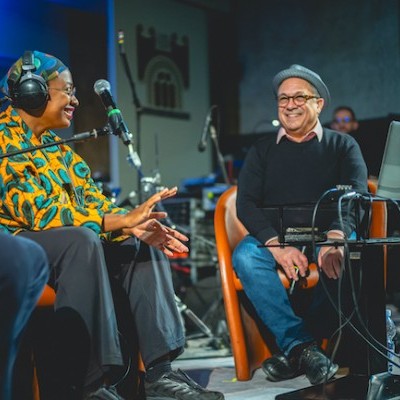Jul 9, 2024 11:35 AM
Trumpeter, Educator Jim Rotondi Dies at 61
Jim Rotondi, a renowned hard-bop trumpeter, composer and educator, died suddenly on July 7 at a hospital in France. He…

Cannonball Adderley (left), Ira Gitler and Dave Brubeck circa 1967
(Photo: DownBeat Archives/James H. Allen)Ira Gitler, who claimed the title “jazz activist” for his multifaceted, seven-decade career and was named a National Endowment for the Arts Jazz Master in 2017, died Feb. 23 at the age of 90, having been hospitalized after a five-year struggle with heart disease. According to his son, Fitz Gitler, Ira was wearing a DownBeat T-shirt and listening to Art Tatum with his wife of 46 years, Mary Jo Schwalbach, when he died.
“Ira was the ideal critic of the bop era,” historian Gary Giddins said, “less dogmatic than some and a whole lot wittier than most. He kept the faith, reporting on the New York scene for decades, long after jazz went into directions he didn’t much like, invariably reliable on what he did like.”
A longtime resident of Manhattan’s Upper East Side and a familiar figure to musicians, Gitler’s work ranged from cub reporter and jazz record label go-fer to freelance writer credited with more than 700 album annotations, as well as program notes, articles, poems and lyrics. He produced classic bebop recordings and countless festivals, was a columnist, editor, author and encyclopedist, radio show host, lecturer and adjunct professor at City Colleges of New York, Manhattan School of Music and The New School. His books Swing to Bop: An Oral History of the Transition in Jazz in the 1940s (1985) and Jazz Masters of the ’40s (reissued as The Masters of Bebop: A Listener’s Guide) remain key documents of the era. And The Biographical Encyclopedia of Jazz (2007), the sixth edition of a work he’d come to in 1954 as an assistant to Leonard Feather, its original author, is acknowledged as a standard reference.
Simultaneous to his work in jazz, Gitler was a professional sports journalist, specializing in ice hockey, publishing several books on the topic and coaching a highly-regarded amateur team.
His first production credit came in 1951 on a Sonny Rollins session. And although he famously coaxed a superior version of “’Round Midnight” from a recalcitrant Miles Davis front line that featured Charlie Parker and Sonny Rollins, he told Jazz Forum’s Paweł Brodowski in a 1989 interview that in recording studios, “I was a liaison between the musicians and the engineers.”
Nonetheless, Gitler’s constant presence on the scene in the ’40s and ’50s heyday of 52nd Street and backstage at clubs, concert halls and festivals into the 21st century, plus his respectful curiosity about newcomers, support-players and established leaders, resulted in well-informed opinions that he delivered in clear and vivid prose: “There is a school of thought that says ‘All sound is music,” Gitler wrote for a 1975 reissue that paired the mid-’50s Prestige recording Gil Evans & Ten and A Study of Dameronia, “but if this were true then you would have to classify the early-morning grinding of a garbage truck or a fingernail running down a blackboard in this category ... . Music is sound but sound is not necessarily music.”
As he told Brodowski, “I choose to write about the things I feel are good and important and that I feel should be publicized. Maybe my role has switched from merely a critic to a jazz activist.”
Born in Brooklyn in 1928, Gitler took piano lessons from a cousin at age five, was soon introduced to jazz by his older brother’s record collection and wrote his first performance review of a Dizzy Gillespie gig at the 52nd Street Spotlite Club for the Columbia Grammar School newspaper in 1946. Already an ardent fan, Gitler led a record-listening group, scat sang and played alto saxophone, and filed jazz reports for the student newspaper at the University of Missouri, which he attended, but did not graduate from. Having formed a close relationship with Prestige founder Bob Weinstock while on school breaks, Gitler joined the label full time in 1950, and in ’51 wrote his first album liner notes for Zoot Sims’ Swings The Blues. He also swept floors, packed boxes, designed album covers and promoted releases to DJs.
As news of Gitler’s death spread, some of the genre’s best-known veterans were effusive about the writer and producer.
“I knew and admired Ira for many years,” tenor saxophonist Benny Golson wrote in an email to DownBeat. “His veracity-filled rhetoric was always well thought out. His writing was never a dalliance, jejune or pell-mell. His mission always seemed to be placing readers inside of things with great understanding. His metaphoric fingers were always on the pulse of surrounding activity. I saw him symbolically retrieve Excalibur from the rock many times. He was a most valuable stitch in the fabric of journalism. We will miss Ira Gitler, who was often joyously ineffable.”
Dan Morgenstern, former director of the Institute of Jazz Studies at Rutgers University, editor of DownBeat during Gitler’s ’60s stints as New York editor, and himself a Grammy-winning record annotator and NEA Jazz Master, mourned Gitler as more than a colleague.
“Ira was my oldest friend. I could not count the times we shared the music, live or recorded, that was our passion,” Morgenstern said. “He loved Charlie Parker and even took up alto—but soon decided this was not his strength, and took up a pen instead. Miles would laughingly reminisce about Ira telling him, ‘You ain’t playing shit,’ one of the anecdotal highlights from Ira’s long career in jazz. He was the dean.” DB

Jim Rotondi was acclaimed for his wide, round trumpet tone, remarkable virtuosity and assured swing.
Jul 9, 2024 11:35 AM
Jim Rotondi, a renowned hard-bop trumpeter, composer and educator, died suddenly on July 7 at a hospital in France. He…

Charles Lloyd, seen here at the 2024 New Orleans Jazz & Heritage Festival, makes DownBeat Poll history!
Jul 11, 2024 12:23 PM
The incomparable Charles Lloyd swept the 72nd Annual DownBeat Critics Poll, becoming the first artist ever to earn…

“Being president of Blue Note has been one of the coolest things that ever happened to me,” Was said. “It’s a gas to serve as one of the caretakers of that legacy.”
Jun 4, 2024 12:21 PM
Sitting with Don Was is a comfortable and unhurried exercise. He may seem slightly reserved at first, but ideas and…

“She reminds me of my childhood and makes we want to cry,” Cécile McLorin Salvant, pictured here with writer Ashley Kahn, said of Dianne Reeves.
Jun 11, 2024 12:31 PM
Italy’s Umbria Jazz Winter is one of those rare annual festivals that not only coincides with a major holiday —…

Maria Schneider said of Decades, her new compilation release: “I just wanted to create something, put it in a beautiful box and say, ‘Look at what we did.‘”
Jun 18, 2024 12:00 PM
Maria Schneider opened the sleek black box and placed it on a coffee table in her Manhattan apartment. Inside lay the…